Occupancy Monitoring
If you are looking for occupancy monitoring equipment that helps you and your team eliminate manual logging, improve compliance readiness, and protect all your temperature-sensitive assets, you’ve arrived at the right place.
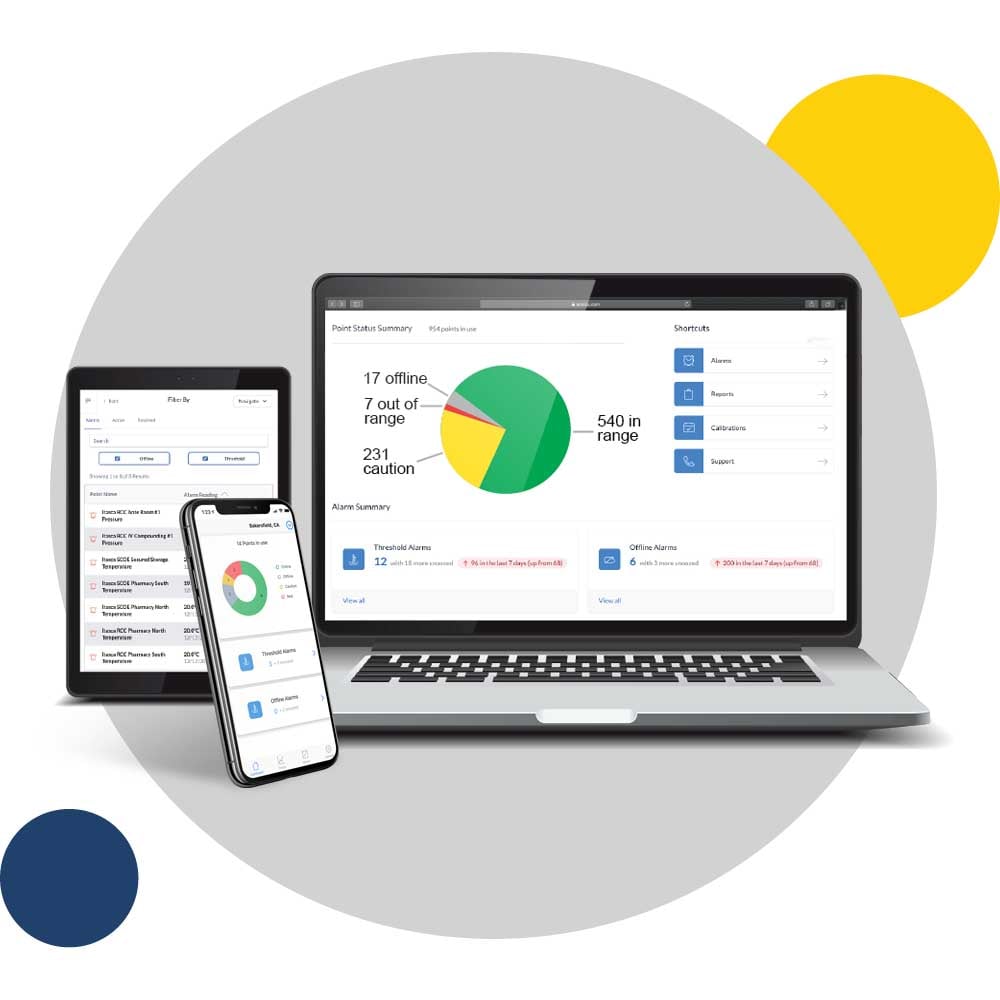
Let us help you evaluate your needs!
- Safety: Alerts via text, email, push notifications and phone calls to protect your precious assets
- Compliance: Automated compliance reports
- Efficiency: Reduced Manual Logging and time spent on reports
And what makes us different?
- Lifetime Warranty: Never buy hardware again!
- Unlimited Users: Scale across your entire organization
- Connectivity Flexibility: Wi-Fi, Cellular or Data Hub
- Phone call alarms: Alerts won't get ignored
- Mobile App: 500 Freezers in your pocket
- Facility monitoring: Simple to add water leak, door open, occupancy, and even IAQ monitoring
Engineered in Indiana with U.S.-based support.

See What Customers Say About Sonicu
Asset Protection. Compliance Automation. And Reduced Manual Processes.
Sonicu serves thousands of professionals at hundreds of organizations across North America by improving how they monitor and manage their most sensitive assets and environments.
Professionals from healthcare, life science, laboratory and cold chain facility management turn to Sonicu to help them improve the way they do business.
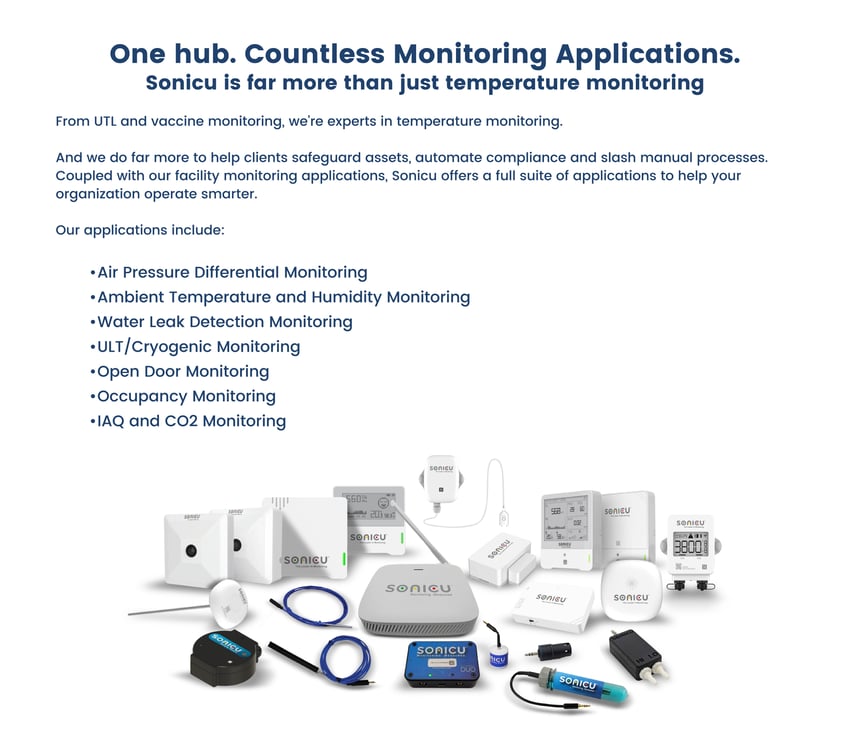
These respected healthcare and research brands turn to Sonicu for four primary reasons:
- Real-Time Monitoring: the sensors collect temperature, humidity, air pressure data and more, and transmit it wirelessly to SoniCloud - our cloud-based platform.
- Operational Efficiency: Virtually eliminate the need for tedious and costly manual logging
- Compliance Automation: Respond to any regulatory audit or inspection in a few clicks with our reports section
- Asset Protection: Detect and respond to any threshold that can threaten anything perishable: food, drugs, vaccines, research, etc.

Cost competitiveness, great customer service, great control over the monitoring system, and low maintenance. You can't beat that.
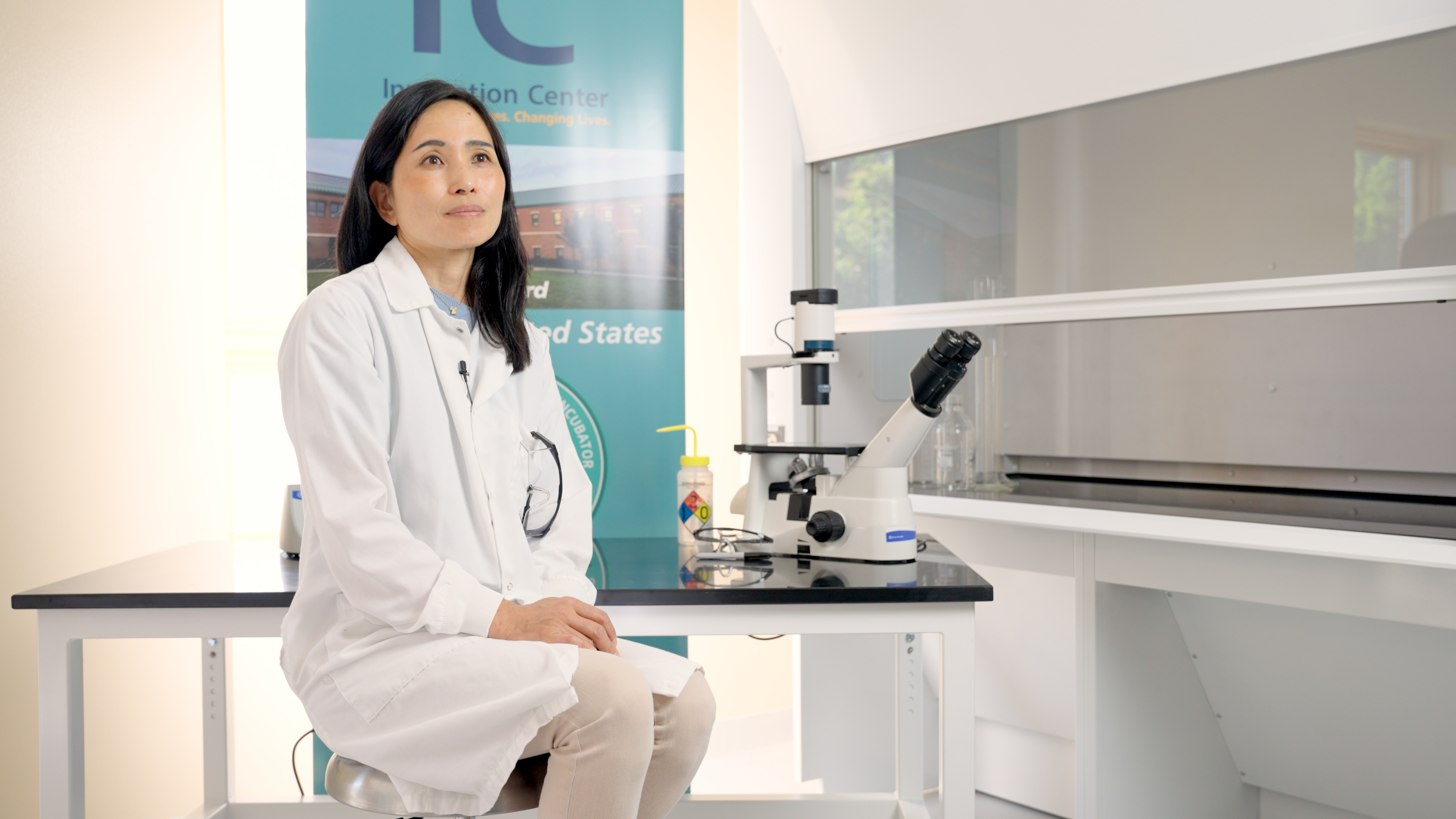
Sonicu costs are considerably more reasonable than our historic system, as well as other competitors on the market. The equipment is robust but simple to learn and utilize.

Having safe and secure storage provides reassurance that any future family building efforts will be protected. Sonicu gave us the ability to more easily put our head on the pillows and sleep easier at night knowing we had invested in a strong monitoring system.”

Revolutionizing Space Efficiency: How Occupancy Monitoring is Changing the Game for Businesses Everywhere
Occupancy monitoring refers to the use of technologies and systems that track the presence and movement of people within a given space or facility. This process can be achieved through various means, including but not limited to, video surveillance, thermal imaging, Wi-Fi tracking, and badge access systems. The primary goal is to understand, in real-time or through historical data, how spaces are utilized, ensuring safety, security, and efficient use of resources. Its importance spans various environments for several reasons.
First, healthcare facilities use these solutions to heighten safety and security by monitoring the flow of visitors and staff, ensuring only authorized personnel access sensitive areas. They help manage patient flow and allocate staff and resources more efficiently. It also assists hospitals in maintaining compliance with health and safety regulations.
In education facilities and universities, occupancy monitoring helps in capacity planning: by ensuring that facilities do not exceed their maximum capacity, which is important for safety and comfort. This process is also useful in enhanced learning environments by optimizing space usage for better learning experiences. They also enhance the safety of students and staff by monitoring unauthorized access.
Retail environments can gain valuable customer insights from these systems as they provide data on shopper behavior, helping to improve layout and product placement. They also help in staffing decisions based on peak and off-peak hours, while also ensuring compliance with occupancy regulations for safety purposes.
Occupancy monitoring in senior living communities assists in monitoring residents to ensure their safety, especially important for those with mobility or cognitive challenges. It also helps in efficiently managing common areas and resources.
Also, commercial and government buildings leverage these solutions to optimize HVAC and lighting based on occupancy, reducing energy consumption. They also enhance security measures and ensure compliance with occupancy standards.
Labatory and life science settings utilize occupancy monitoring to ensure that occupancy levels are maintained to prevent contamination, monitoring for unauthorized access to sensitive or hazardous areas.
Pharmacies and cleanrooms rely on these devices to meet compliance with strict regulatory standards regarding cleanliness, and safety more hassle-free. They monitor and control access to maintain cleanliness standards and protect sensitive materials.
The impact of occupancy monitoring on day-to-day operations across industries is immense.
To begin with, it ensures that only authorized individuals access certain areas, and also manages crowd sizes to prevent accidents.
By understanding space utilization, organizations can also optimize the use of resources, reduce energy consumption, and improve overall operational efficiency.
Occupancy monitoring systems generate valuable data that can inform decision-making processes, from strategic planning to daily management tasks.
Many sectors have strict regulations regarding occupancy levels and safety standards. Occupancy monitoring helps ensure these standards are met.
The importance of occupancy monitoring across various sectors cannot be overstated. It plays a crucial role in enhancing safety, improving operational efficiency, providing valuable insights, and ensuring regulatory compliance, thereby significantly impacting the day-to-day operations of these environments.
You can learn more about how our software helps compliance professionals in these case studies:
Problem: Pharmacy Suffered Too Much Humidity In New Wing, impacting Compounding Pharmacy
Solution: Affordable Humidity Monitoring that Delivered Powerful data to prompt contractors to fix improperly sized air handler
Problem: The dining department struck with regulatory violations
Solution: Enterprise-wide monitoring that automates regulatory compliance across all departments
Problem: Release of lead particles in battery projects
Solution: Mobile, affordable air pressure monitoring solution
What are the components of occupancy monitoring systems?
Occupancy monitoring systems are composed of various components and technologies designed to accurately track and manage the use of spaces. These systems can vary widely in complexity and functionality depending on the specific needs of the environment in which they are deployed.
- Sensors:
- The primary component used for detecting presence and movement within a space.
- Passive Infrared (PIR) sensors detect body heat to determine if someone is in that space.
- Ultrasonic sensors emit ultrasonic waves and measure the reflection off moving or stationary objects.
- Video cameras utilize advanced video analytics to count and track occupancy.
- Thermal cameras detect heat signatures to monitor occupancy without compromising privacy.
- Wi-Fi trackers use the strength of Wi-Fi signals from smartphones and devices to estimate the number of people present.
- Data processors:
- Systems that process the data collected by sensors.
- They can be standalone computing devices or cloud-based platforms, analyzing sensor data to generate actionable insights.
- Software applications:
- Occupancy monitoring software interprets the data from processors to provide a user-friendly interface for managing and visualizing occupancy information.
- These applications often offer features such as real-time occupancy data, historical trends analysis, and alerts for when occupancy limits are reached.
- Communication networks:
- Essential for the transmission of data between sensors, processors, and user interfaces.
- These can include wired networks (Ethernet) and wireless technologies (Wi-Fi, Bluetooth,Cellular).
- Internet of Things (IoT):
- Connects various sensors and devices to collect and analyze data in real-time, enabling efficient occupancy monitoring across large and complex facilities.
- Edge computing:
- Processes data on or near the sensors to reduce latency and bandwidth use, ensuring real-time responses and alerts.
- Cloud computing:
- Offers scalable data storage and processing capabilities, allowing for the aggregation of data from multiple sources and enabling advanced analytics and remote access.
Each technology and component within an occupancy monitoring system plays a vital role in its overall efficiency and effectiveness.
By leveraging these technologies, occupancy monitoring systems can provide accurate, real-time data on space utilization, enhance security and safety, improve energy efficiency, and enable data-driven decision-making in facility management.
What are the pain points that occupancy monitoring resolves effectively?
Occupancy monitoring systems tackle a range of stubborn pain points across various industries by providing data-driven insights and automation that enhance efficiency, safety, and user experiences.
Problem: Many organizations struggle with underused or overcrowded spaces, leading to inefficiencies and increased operational costs.
Solution: Occupancy monitoring provides real-time data on space utilization, helping organizations optimize the use of their facilities, plan for future needs, and reduce costs associated with underused spaces.
Problem: Buildings often consume energy for lighting, heating, cooling, and ventilation for spaces that are not in use, contributing to significant energy waste.
Problem: Ensuring compliance with health, safety, and occupancy regulations can be challenging, especially in environments such as hospitals, schools, and commercial buildings where occupancy levels fluctuate.
Solution: Occupancy monitoring systems enable real-time tracking of the number of people in a space, ensuring that organizations can adhere to regulations and guidelines to maintain safe environments.
Problem: Unauthorized access and unmonitored spaces pose significant security risks, including theft, vandalism, and potential harm to individuals.
Solution: These systems enhance security by monitoring access to restricted areas, detecting unusual activity, and enabling a rapid response to security breaches.
Problem: Overcrowding or poorly managed spaces can lead to a negative experience for customers in retail settings or for employees in office environments.
Solution: By monitoring occupancy levels, businesses can manage crowds, reduce wait times, and optimize workspace layouts, thereby improving satisfaction and productivity.
Problem: In emergencies, quickly understanding the occupancy and distribution of people within a facility can be difficult, hindering evacuation efforts.
Solution: Occupancy monitoring systems can provide critical information during emergencies, aiding in efficient evacuation and ensuring that first responders know occupancy levels and potential areas of concern.
Problem: Organizations often face challenges in efficiently allocating staff and resources due to fluctuating demand and occupancy levels.
Solution: With insights from occupancy data, businesses can adjust staffing levels in real-time, align operational activities with actual demand, and thus optimize labor costs and operational efficiency.
Occupancy monitoring systems, through their comprehensive and adaptable approaches, address these persistent challenges across industries by enabling smarter, safer, and more sustainable management of spaces.
By leveraging the power of data analytics and IoT, these solutions not only resolve current pain points but also offer a foundation for continuous improvement and innovation in facility and resource management.
Key benefits of occupancy monitoring
- These systems ensure that only authorized personnel access sensitive or restricted areas, reducing the risk of unauthorized entry and enhancing overall security. In case of emergencies, real-time occupancy data aids in efficient evacuation and emergency response.
- Occupancy data allows for the intelligent use of space, helping organizations to understand how their facilities are utilized. This can lead to better space planning, reduced real estate costs, and an enhanced ability to adapt to changing needs.
- The insights gained from occupancy monitoring enable organizations to make informed decisions regarding facility management, layout adjustments, and resource allocation. This data-driven approach leads to more effective operations and strategic planning.
- Occupancy monitoring systems help ensure compliance with safety and health regulations, including occupancy limits and social distancing guidelines, by providing accurate, real-time data on the number of people in a space.
- For retail environments and workplaces, understanding occupancy patterns can help in creating a better experience for customers and employees. It enables businesses to manage crowds, reduce wait times, and allocate resources where they are most needed, thus improving satisfaction and productivity.
- By optimizing energy usage, improving space utilization, and enabling efficient resource allocation, occupancy monitoring systems can lead to significant cost savings for organizations.
- Modern occupancy monitoring solutions are often modular and scalable, allowing for easy expansion or adjustments based on changing requirements or technological advancements.
- Advanced occupancy monitoring technologies, such as anonymous video analytics and thermal imaging, provide accurate data without compromising individual privacy, addressing concerns related to surveillance.
- In emergencies, having access to accurate, real-time occupancy information can be lifesaving, facilitating quicker and more organized evacuation procedures and emergency responses.
In addition to aiding occupancy monitoring, Sonicu plays a vital role for organizations in other industries such as Ohio University and others including:
- Healthcare: Nurses respond to our alerts to keep your medicine safe
- Life Science/Lab: Lab directors rely on our alerts to protect priceless research
- Food Service: Food distributors rely on our tech to protect your dinner
Unlocking Smarter Spaces: Discover the Sonicu Difference in Occupancy Monitoring
In wrapping up our exploration of the transformative impact of occupancy monitoring across various sectors, it's clear that the key to unlocking efficiency, safety, and smart space management lies in harnessing the power of advanced technology.
Sonicu emerges as a beacon in this landscape, offering cutting-edge solutions that not only promise but deliver on the premise of smarter, safer, and more sustainable environments.
From cleanrooms to educational facilities, and from retail environments to senior living communities, Sonicu's occupancy monitoring system stands out as a paragon of innovation. With its state-of-the-art sensor technology and real-time monitoring capabilities, Sonicu guarantees not just surveillance over occupancy levels but a comprehensive, proactive approach to space management. This is not just about keeping spaces within safe occupancy limits; it's about redefining what it means to manage and utilize space intelligently.
Companies such as Nomi Health have trusted Sonicu to provide them with peace of mind when it comes to temperature monitoring. Other benefits they receive by choosing Sonicu include:
- Asset Protection: Get alerts when a freezer is malfunctioning to protect assets like medicines, vaccines, blood, research, sperm/eggs
- Compliance Automation: Creates simple reports to satisfy local/state/federal regulations
- Operational Efficiency: Spend less time capturing data manually: Both temps/conditions and reporting
Sonicu's advanced sensors provide precise, reliable measurements, ensuring that occupancy remains within designated parameters. This isn't just occupancy monitoring; it's occupancy intelligence. With real-time alerts delivered via call, text, email, and push notifications, and the ability to manage these alerts directly from your device through the SoniCloud mobile app, Sonicu simplifies safety and compliance, making it accessible, manageable, and responsive.
Sonicu goes beyond mere monitoring; it offers a suite of features designed to address the unique challenges of each environment it serves. The SMART Sensors and advanced alarming system reduce alarm fatigue and enable tailored alarming to spot trends, ensuring that every alert you receive is meaningful and actionable. The all-digital, easy-to-calibrate probes, industry-leading battery life, and the safest network on Verizon's cellular platform, ensure that your monitoring system is always on, always accurate, and always secure.
In a world where efficiency, safety, and compliance are not just goals but necessities, Sonicu stands as your partner in achieving these objectives with ease and confidence. Whether you're looking to streamline operations, enhance safety protocols, or ensure regulatory compliance, Sonicu's occupancy monitoring solutions are tailored to meet these needs head-on.
Take the first step towards smarter space management with Sonicu.
Discover how our occupancy monitoring solutions can transform your facility, ensuring not just compliance and safety but a future where every space is optimized, every resource is utilized to its fullest, and every decision is informed by real-time, actionable data.
Visit us today to learn more about the Sonicu difference and how we can help you achieve smarter, safer, and more sustainable space management.
Experience the future of occupancy monitoring with Sonicu – Safety. Simplified.
American-based Customer Support: Robust & Reliable High Touch Service
Experience Unparalleled Service with Sonicu's Dedicated Team
At Sonicu, we understand that the true value of software and technology lies in the people who stand behind them.
Our probes and sensors are purposefully designed to withstand the harshest frozen environments, working tirelessly to collect and transmit billions of bits of data every month.
We recognize that even with the most advanced technology, occasional hiccups can occur, whether it's on the hardware or software side. But rest assured, our commitment to you is unwavering.
That's why we take pride in our team of dedicated American-based customer success managers, always ready to assist you with any service issues. With Sonicu, help is just a phone call away, ensuring a seamless experience for our valued customers.
At Sonicu, we prioritize customer satisfaction and swiftly address any support request that comes our way. Our responsive team is dedicated to resolving issues promptly and getting our customers back online without delay.
Our customers are highly educated and protect highly valuable assets with our solutions. We boast more than 95 percent customer retention thanks to our reliable hardware, intuitive software and robust customer support.
We are committed to fielding every customer service request promptly and getting our customers online rapidly.

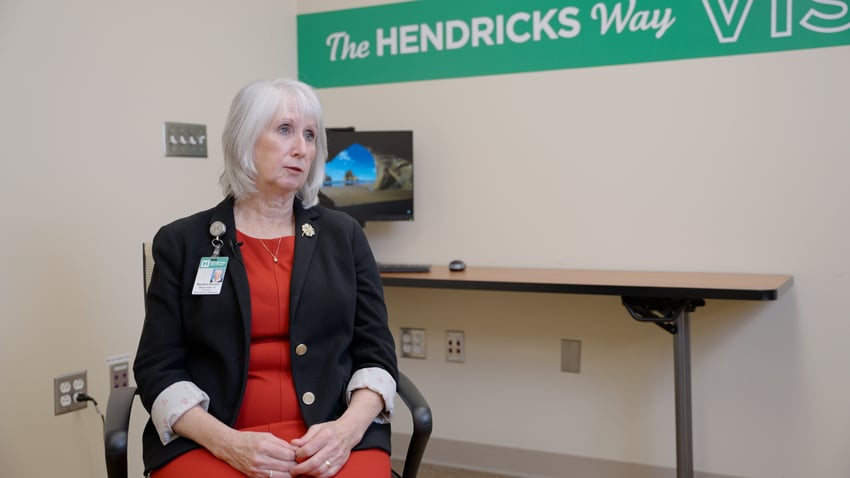 “I like to say that every refrigerator or freezer is like a car in that they all behave a bit differently,
“I like to say that every refrigerator or freezer is like a car in that they all behave a bit differently,
and then every now and then you just get a bad boy who doesn’t want to perform as we need it to,”
Martha Rardin, Director, Nutrition and Dietetics, Hendricks Regional Hospital.
 “Sonicu has been a powerful tool to identify which units are behaving out of spec and get our team
“Sonicu has been a powerful tool to identify which units are behaving out of spec and get our team
to fix them before we have a serious issue.”
Tim Livesay, Director, Hancock Regional Hospital Pharmacy Director









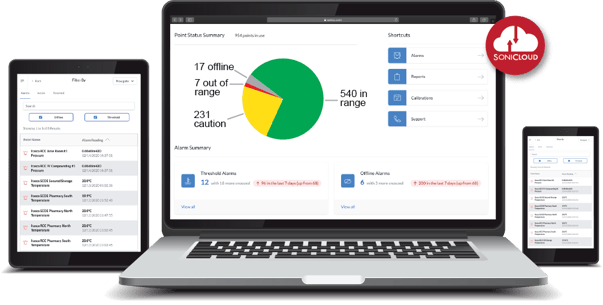
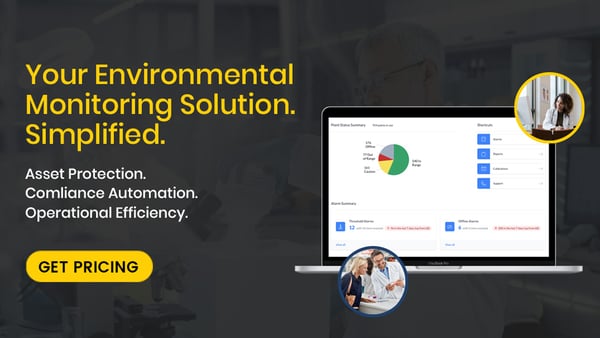
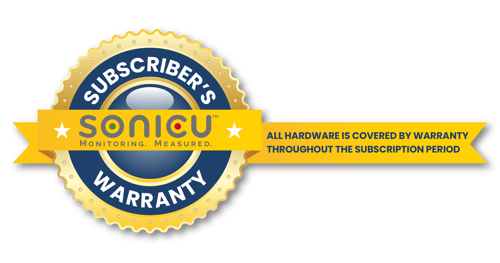


How IU Health
consolidated all of its pharmacy monitoring needs
into one cloud-based platform serving dozen of locations.